- Details
- Written by Peter Miller Peter Miller
- Published: 15 May 2014 15 May 2014
- Hits: 6098 6098
September 13, 2012
Peter Miller
With technical assistance by Steven Miller
On the second day of the 2012 Democratic National Convention, the world was treated to a spectacle of voter fraud on national TV. The Democratic leadership, apparently at the behest of President Obama, brought forth last minute changes to the language of the Democratic platform that required a 2/3rd vote of the convention delegates. There were two changes, quickly shown and obviously intended to be pushed through: introducing the word “God” into the platform, and affirming that Jerusalem is the capital of Israel. After three attempts and obviously lacking the required 2/3rd vote, the convention chairman, Los Angeles Mayor Antonio Villaraigosa, ignored the voice of the delegates and continued reading the scripted proceedings from his teleprompter, announcing that the Ayes had won. Amidst boos and looks of disgust, Villaraigosa soldiered on, the teleprompter trumping the vote. Jon Stewart commented, “On the bright side we’ve finally discovered the evidence of Democratic voter fraud the Republicans are always complaining about.”
An audio analysis of the Yes (Aye) and No votes demonstrates that not only was there not a 2/3rd majority in favor of changing the language, but that the No vote was louder by at least 162% meaning that the changes were defeated by a majority of 62% to 38%. This is close in fact to a two third majority in favor of the No votes. Of course, if the votes had actually been counted, perhaps it would have gone differently, the loudness of the No votes might simply be evidence of the anger of delegates watching their democratic rights trampled before their eyes in the name of a foreign country. The one chance the delegates had to actually make a real decision at the convention, even though cynically presented to them, was shabbily and fraudulently denied them.
As this little study makes it obvious, the voice vote extremely problematic as an measure of voter intent. As was also obvious from the floor of the Democratic convention, people always have to struggle to make democracy work or it will not happen.
Americans have real and valid concerns about how democratic their system is and the concerns over voter suppression by Republicans are real enough. But the Democratic Party’s elite made it clear how little they themselves value real democracy. Thanks to this fraudulent vote, everyone has a much better idea now what goes on behind the scenes in the back rooms, out of reach of the people, and a much better idea of what the priorities of the Democratic party really are. Naturally, the Democrats are not unique in this respect. Just ask the Ron Paul delegates at the Republican convention.
It is understandable that the rank and file will be loath to revisit this vote during this time of campaigning, in the middle of our festival of fear, cynicism, money, and extreme partisanship that is our presidential election. Also, there can be no doubt that the Democratic party leadership will seek to make sure this fraud does not happen again by making sure Democrats get as few opportunities as possible to have any real say on the platform or the direction of the party, especially on controversial issues. Focus groups and big money donors will drive the Democratic Party positions as much as possible and outbreaks of democracy, especially on the floor of the convention must be avoided. So democracy, accountability, and open debate will simply take a back seat yet again.
In repayment for this debasing spectacle at the Democratic convention, Israeli Prime Minister Netanyahu quickly made Israel and war with Iran a hot campaign issue, openly criticizing Obama in the middle of the US presidential campaign that Obama is not tough enough on Iran and needs to set “red lines” (read: willingness to go to war) or Israel is free to start a war itself (read: and the US will be sucked in and have to support Israel anyway). Once again Israel intrudes on our democracy. And this time, it for extremely dangerous reasons.
The question remains, can they hear us now?
====================
Addendum
The details of the analysis follows:
In the spirit of “Why argue verifiable facts?” a youtube video of the vote was found and an mp4 of the vote was downloaded (see http://www.youtube.com/watch?v=cncbOEoQbOg). Two programs were used to analyze the sounds on a Macintosh: the appropriately named Audacity, the open source sound editing software, and Amadeus, a commercial sound editing program. Both programs were used to compare the loudness of the final Aye vote with the sound of the final No vote. Decibels, which are logarithmic, were converted to sound intensity (constant * watts / square meter), which is linear. Both programs indicated that the No vote was louder by about 162-170%. Note that the numbers that follow represent the standard decibel (dB) measurements and a larger negative number is quieter than a smaller negative number. Using Amadeus’ Sound Statistics option, the Aye vote average RMS was -25.9dB, the No vote average RMS was -23.6dB, a difference of 2.3dB. Converting to sound intensity, the Aye vote had an intensity of 0.00257 and the No vote had an intensity of 0.004365, the No vote was 170% louder. Using Audacity’s Contrast Analyzer, the Aye vote was -26.2dB, the No vote was -24.1dB, a difference also of 2.1dB. Converting to sound intensity, the Aye vote in this case had an intensity of 0.002399 and the No vote had in intensity of 0.00389, the No vote was 162% louder.
The formula used to convert from Decibels to Intensity is:
Sound intensity = 10^(Decibels/10)
Among some assumptions are made:
1) The words Aye and No deliver equivalent levels of sound.
2) The audio was captured correctly in the chamber and had not been altered before it got to me.
3) For example, angry people are probably louder than compliant people, so it is very difficult to map sound volume to actual numbers of people.
I tried different ways of measuring the average: selecting the last one second of each sound, selecting the middle one second of each sound, selecting the entire sound and so forth and the results were consistent.
The Aye/Yes vote in Audacity: 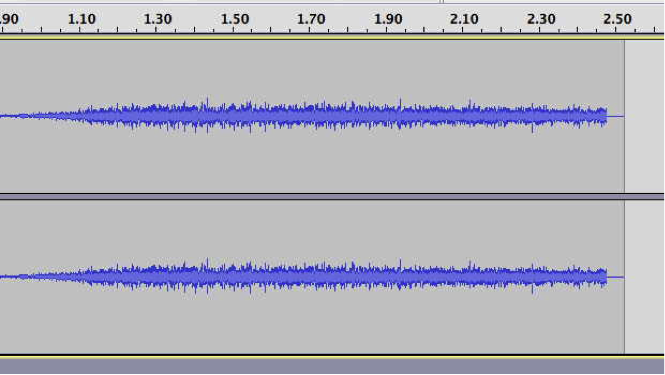
The No vote in Audacity: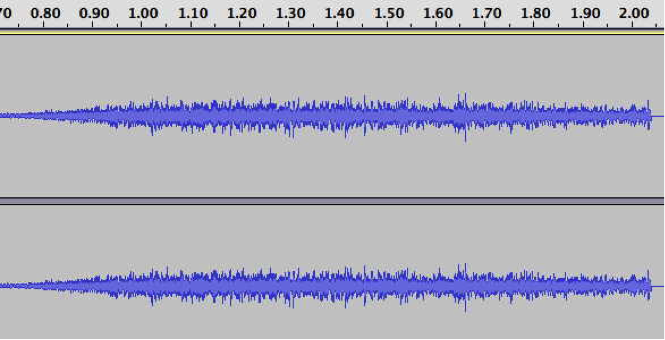
In Amadeus:
Aye/Yes vote average RMS is -25.9. No vote average RMS is -23.6, a difference of 2.3db (9.7%). Converting to sound intensity, the Yes vote had an intensity of 0.00257 and the No vote had an intensity of 0.00436, a difference of 0.00179 (69.65%) in favor of the No vote.
The Aye/Yes Vote in Amadeus:
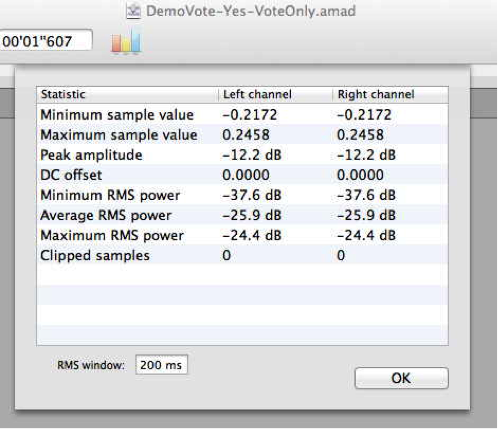
The No Vote in Amadeus:
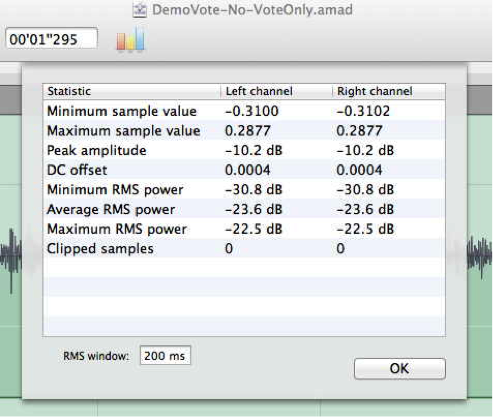
In Audacity: Top selection (Foreground) is the No vote
Bottom selection (Background) is the Aye vote
Aye/Yes average is -26.2db and No average is -24.1db, the No vote is louder by 2.1dB louder (8%). Converting to sound intensity, the Yes vote has an intensity of 0.00240 and the No vote has an intensity of 0.00390, a difference of 0.0015 (62.5%).
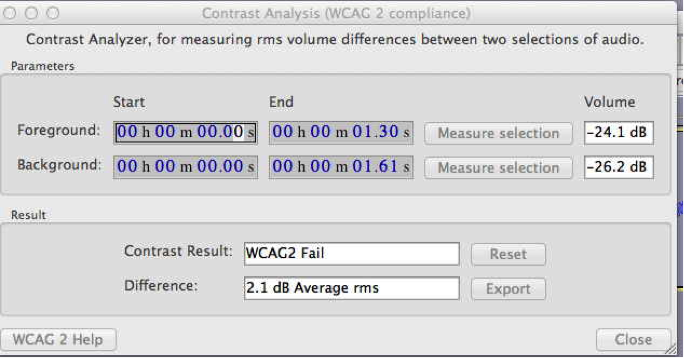
WCAG 2.0 Audio Audio Contrast Tool Help
For Success Criteria 1.4.7
http://www.eramp.com/WCAG_2_audio_contrast_tool_help.htm
See also:
Amidst Boos And Multiple Votes, DNC Reverses Position And Reinstates Jerusalem
http://www.youtube.com/watch?v=cncbOEoQbOg
Hope and change 2 – Democratic platform amendments
http://www.thedailyshow.com/watch/thu-september-6-2012/hope-and-change-2---democratic-platform-amendments
Ron Paul Delegates Cause Mayhem At Republican Convention
http://www.huffingtonpost.com/2012/08/28/ron-paul-republican-convention_n_1837556.html
Democrats' Efforts To Reinsert 'God' And 'Jerusalem' Into Platform Met With Loud Opposition (VIDEO)
http://www.huffingtonpost.com/2012/09/05/dnc-god-jerusalem-platform_n_1859200.html
Israeli Sharpens Call for United States to Set Iran Trigger
http://www.nytimes.com/2012/09/12/world/middleeast/united-states-and-israel-engage-in-public-spat-over-iran-policy.html?pagewanted=all
Decibels compare power levels
http://som.csudh.edu/cis/lpress/471/hout/wireless/db.htm
DECIBEL (dB)
http://www.sfu.ca/sonic-studio/handbook/Decibel.html
Below is a static view of the spreadsheet used to calculate the intensity values and percentages from the decibel figures:
|
Sound Power Level (Decibels) |
||||||
|
Minimum |
Average |
Maximum |
||||
|
Yes |
-37.6 |
-26.2 |
-24.4 |
|||
|
No |
-30.8 |
-24.1 |
-22.5 |
|||
|
Sound Intensity (constant * watts/square-meter) |
||||||
|
No |
0.000831764 |
0.003890451 |
0.005623413 |
|||
|
Yes |
0.00017378 |
0.002398833 |
0.003630781 |
|||
|
Ratio of No vs Yes votes |
479% |
162% |
155% |
|||
|
% of Votes that were No |
83% |
62% |
61% |
|||
|
% of Votes that were Yes |
17% |
38% |
39% |
|||
|
Notes: |
||||||
|
The original audio levels are expressed as negative numbers because they are measured relative the distortion level which is the maximum audio signal that can be recorded without distortion with the equipment and settings used to make the recording. |
||||||
|
Sound intensity = 10^(Power/10) |
||||||
|
Power = 10* Log10(Sound Intensity) |
||||||
Notes:
The original audio levels are expressed as negative numbers because they are measured relative the distortion level which is the maximum audio signal that can be recorded without distortion with the equipment and settings used to make the recording.
Sound intensity = 10^(Power/10)
Power = 10* Log10(Sound Intensity)
